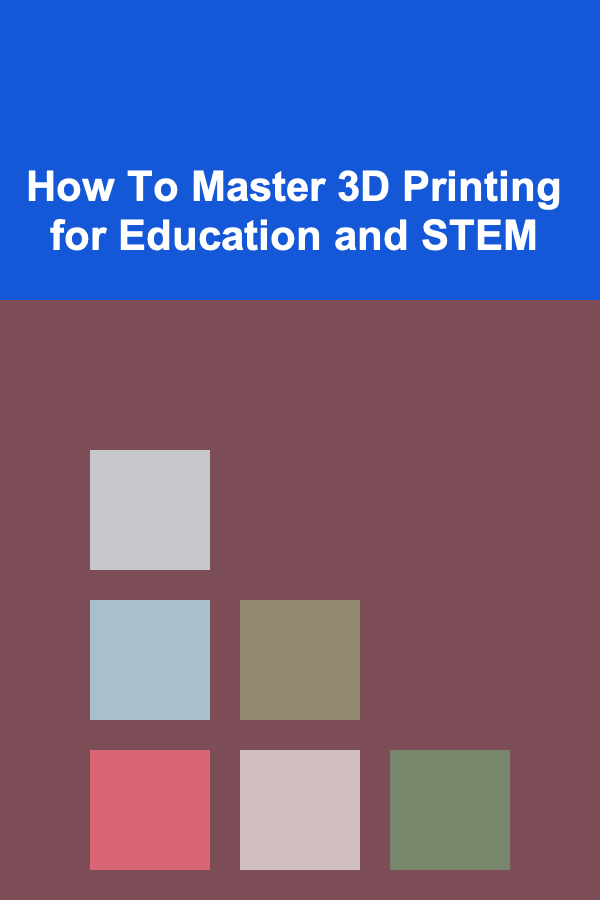
How To Master 3D Printing for Education and STEM
ebook include PDF & Audio bundle (Micro Guide)
$12.99$9.99
Limited Time Offer! Order within the next:

The advent of 3D printing has revolutionized industries across the globe, from manufacturing and healthcare to entertainment and education. For educators and students in the fields of Science, Technology, Engineering, and Mathematics (STEM), 3D printing offers a wide range of possibilities to enrich learning, create innovative models, and turn abstract concepts into tangible objects.
In this article, we will explore how educators, students, and schools can master 3D printing for STEM education. We will cover the basics of 3D printing, its applications in the classroom, and the tools and resources needed to leverage this cutting-edge technology for learning and innovation.
What Is 3D Printing?
3D printing, also known as additive manufacturing, is a process in which objects are created layer by layer from a digital model. Unlike traditional manufacturing methods that often involve cutting away material from a larger block, 3D printing builds up objects by adding material precisely where it is needed. The result is a highly customizable and precise creation process that can be used for a vast range of applications.
The materials used in 3D printing are diverse, including plastics (such as PLA, ABS), metals, ceramics, and even biological materials. The most common method of 3D printing is Fused Deposition Modeling (FDM), which uses a heated nozzle to extrude plastic filament onto a build platform.
The Importance of 3D Printing in Education and STEM
Incorporating 3D printing into education, particularly STEM, offers numerous benefits. It helps bridge the gap between theory and practice by allowing students to create physical models of abstract ideas. Students are no longer just learning about geometric shapes, engineering designs, or molecular structures in theory, but can now physically interact with them.
Some of the primary reasons for incorporating 3D printing into STEM education include:
- Enhancing Creativity and Problem-Solving Skills: 3D printing encourages students to think creatively by turning their designs and ideas into physical objects. This hands-on experience enhances critical thinking and problem-solving skills as students face challenges related to material properties, design constraints, and production methods.
- Making STEM More Accessible: For students who may struggle with traditional learning methods, 3D printing makes abstract concepts tangible. Whether it's a model of the human circulatory system, a working mechanical arm, or a simulation of a biological process, students can visualize and interact with complex STEM concepts in a more engaging way.
- Promoting Collaborative Learning: 3D printing fosters collaboration between students, as it often involves teamwork. Students can work together on creating prototypes, solving design issues, or even presenting their ideas and innovations to the class. This collaborative approach simulates real-world teamwork and builds communication skills.
- Enhancing Engagement and Motivation: Engaging with cutting-edge technology like 3D printing can motivate students, particularly those in STEM fields. The excitement of creating their own prototypes or models can inspire students to pursue further study and exploration in STEM fields.
How 3D Printing is Transforming STEM Education
1. Hands-On Learning and Prototyping
One of the most powerful uses of 3D printing in education is its ability to bring abstract STEM concepts to life through prototyping. Students can design prototypes, test them, and refine their designs iteratively. For example, an engineering student can design a mechanical gear system and print out a working prototype. This allows them to physically test their design and understand how the parts interact, something that would be difficult to achieve without hands-on experience.
2. Visualization of Complex Concepts
In subjects like mathematics, biology, and physics, certain concepts are difficult to visualize, which can make them harder to understand. By using 3D printing, students can create physical models to better understand complex ideas.
For instance:
- In Mathematics, students can print 3D geometric shapes such as polyhedra, graphs, and fractals to deepen their understanding of geometry and topology.
- In Biology, students can create and study models of cells, organs, and molecules, making abstract biological systems tangible.
- In Physics, students can print models to demonstrate forces, levers, and other mechanical systems.
3. Creating Educational Tools and Models
Teachers can use 3D printing to design educational tools and models that enhance the learning experience. For example, a teacher might print out interactive models of historical landmarks for a history class or print scientific instruments to aid in experiments. 3D printing enables teachers to create tailored, custom teaching materials that align with their lesson plans and student needs.
4. Simulating Real-World Engineering and Design Challenges
3D printing allows students to simulate real-world engineering and design challenges. For example, students in an engineering class might be tasked with designing a bridge, a functional drone, or a model of a building. They can use CAD software to design their models and print them to test their functionality. By building prototypes, students gain a deeper understanding of the engineering design process, including trial and error, prototyping, and testing.
5. Bringing Creative Art into STEM Education
STEM isn't just about science and math; it also includes creativity and design. 3D printing can be used to integrate art into STEM subjects, encouraging students to explore the intersections of technology and creative expression. For example, students might design and print sculptures, jewelry, or architectural models, learning about both the artistic and technical aspects of design.
Getting Started with 3D Printing in the Classroom
1. Choosing the Right 3D Printer
There are numerous 3D printers available on the market, ranging from entry-level machines to professional-grade models. When choosing a 3D printer for educational purposes, factors like ease of use, printing speed, and material compatibility should be taken into consideration.
For beginners, FDM printers are the most affordable and commonly used in educational settings. Brands like Prusa , Creality , and Anycubic offer quality machines for schools and universities at an affordable price. These printers are generally easy to use, require little maintenance, and have a wide variety of compatible materials, such as PLA and ABS plastics.
As students progress in their 3D printing projects, educators can explore more advanced options like resin printers or laser sintering machines, which offer higher precision but are more complex to operate.
2. Learning 3D Design Software
Students will need to learn how to use 3D design software in order to create their own models for printing. There are many user-friendly 3D design programs available for all skill levels, from beginner to advanced.
For beginners, Tinkercad is a great option. It's free, web-based, and allows students to design simple models using basic shapes and tools. SketchUp is another accessible program, popular for architectural designs.
For students who are ready to take their skills further, programs like Fusion 360 and Blender offer more advanced features for modeling, animation, and rendering. These tools are widely used in professional design and engineering, making them valuable for students pursuing careers in these fields.
3. Learning About Materials and Printing Techniques
To make the most of 3D printing, students need to understand the various materials available and how they affect the printing process. Common 3D printing materials include:
- PLA (Polylactic Acid): A biodegradable, environmentally friendly plastic often used for general-purpose printing.
- ABS (Acrylonitrile Butadiene Styrene): A stronger plastic used for more durable models, but it requires a heated bed and ventilation.
- PETG (Polyethylene Terephthalate Glycol): A more durable and flexible plastic, often used for engineering applications.
- Resins: Used in resin printers, these materials offer high detail and accuracy, making them ideal for jewelry, models, and small prototypes.
Educators should also teach students about the various printing techniques, including how to optimize settings for different materials, ensure proper adhesion to the print bed, and minimize errors like warping or stringing.
4. Incorporating 3D Printing into the Curriculum
To fully integrate 3D printing into the classroom, educators should incorporate it into lesson plans and projects across a variety of STEM disciplines. This might involve:
- Using 3D models to help students visualize scientific phenomena.
- Encouraging students to design and print their own projects as part of assignments or lab experiments.
- Hosting design challenges and competitions, where students work in teams to create innovative 3D-printed solutions to real-world problems.
Incorporating 3D printing into the curriculum can help students learn in a more engaging and interactive way, encouraging them to think critically and creatively.
Overcoming Challenges in Implementing 3D Printing in Education
While 3D printing offers great opportunities for STEM education, there are some challenges that educators must address. These include:
- Initial Costs: The cost of purchasing 3D printers, materials, and software can be prohibitive for some schools, particularly those in lower-income areas. However, there are often grants and funding options available to help cover these costs.
- Time and Learning Curve: Learning to use 3D printers and design software can take time, and there may be a learning curve for both students and teachers. Professional development for educators and guidance for students can help alleviate these challenges.
- Maintenance and Repairs: 3D printers require regular maintenance and occasional repairs, which can be time-consuming. It is important for schools to have technical support or a dedicated staff member to manage the printers.
The Future of 3D Printing in Education
As 3D printing technology continues to evolve, it is likely that it will become an even more integral part of STEM education. With advances in materials, software, and printing techniques, 3D printing will allow students to design and create even more complex and innovative projects. The integration of artificial intelligence (AI) and machine learning into 3D printing is also on the horizon, offering even greater opportunities for customization and automation.
By embracing 3D printing, educators can prepare students for the future, providing them with the skills and knowledge needed to thrive in an increasingly digital and technological world.
Conclusion
Mastering 3D printing for education and STEM requires a combination of the right tools, skills, and mindset. By integrating 3D printing into STEM education, educators can enhance student engagement, promote creativity, and provide a hands-on approach to learning that will help students better understand complex concepts. As technology continues to evolve, the possibilities for 3D printing in education are endless, offering exciting new ways to innovate and inspire the next generation of STEM leaders.

How to Organize Your Garden Tools for Easy Access
Read More
How to Use Lighting to Make Small Spaces Feel Bigger
Read More
How to Use Photo Boxes for Craft Supply Organization
Read More
Smart Strategies for Cutting Down on Restaurant and Coffee Shop Expenses
Read More
How To Craft a Satisfying Resolution
Read More
The Step-by-Step Guide to Positive Thinking
Read MoreOther Products

How to Organize Your Garden Tools for Easy Access
Read More
How to Use Lighting to Make Small Spaces Feel Bigger
Read More
How to Use Photo Boxes for Craft Supply Organization
Read More
Smart Strategies for Cutting Down on Restaurant and Coffee Shop Expenses
Read More
How To Craft a Satisfying Resolution
Read More